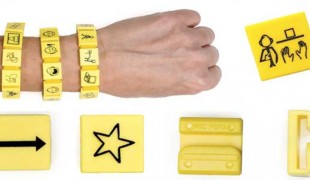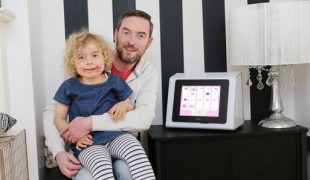- 3971
- 361
- 7
- 6
- 0
- Help Ukraine
About the solution
Quickly after her son was diagnosed with autism, Denise went to learn more about visual cues (single-image pictures that help those with language and communication challenges perform everyday tasks). This process takes advantage of the fact that people with autism think in pictures, so visual cues help them follow a schedule, manage behaviour, tolerate new activities, and communicate with others.
The mother started using visual cues with her son and realised that her son’s behaviour and language skills improved dramatically with the use of visual cues. However, the cues were often time-consuming to make and cumbersome to transport and manage. And she also wanted to share this successful communication method with other people who lived with autistic patients. This meant that Denise had to invent her own visual cues so that they were portable, fashionable and fun to use.
That’s how she had the idea to create a silicone bracelet with visual cues. “If I only had cues on a bracelet, then I could capture teachable moments in any setting”, she recalled. And that’s when the QCharm Portable Visual Cue System was born. The device displays visual cues printed on flat-surfaced charms that clip onto silicone wristbands, helping the user to get to an activity to another without a meltdown.
According to the inventor, the greatest advantage of this solution is how the bracelet helps caregivers and teachers to manage the patients’ needs more easily, allowing them to leave the house and participate in activities with others.
Denise founded her own company around this device. However, she closed it in 2014, when she and her family moved to Wales, UK.
Adapted from: https://longitudes.ups.com/qcharm/
More info: https://www.facebook.com/QCharmLLC/
https://www.youtube.com/watch?v=CIH9rqlKdww
This solution shall not include mention to the use of drugs, chemicals or biologicals (including food); invasive devices; offensive, commercial or inherently dangerous content. This solution was not medically validated. Proceed with caution! If you have any doubts, please consult with a health professional.
DISCLAIMER: This story was written by someone who is not the author of the solution, therefore please be advised that, although it was written with the utmost respect for the innovation and the innovator, there can be some incorrect statements. If you find any errors please contact the patient Innovation team via info@patient-innovation.com
-
-
486
-
0
-
5803

Mother develops a visual cues wristband for her son
COMMUNICATION: Communicating, whether by speaking, listening, or other means
Autism
Body-Worn solutions (Clothing, accessories, shoes, sensors...)
Assistive Daily Life Device (to help ADL)
Anxiety
Difficulty concentrating or making decisions
Irritability or anger outbursts
Restlessness or feeling slowed down
Loss of interest or pleasure in activities (anhedonia)
Sleep disturbances
Managing Neurological Disorders
Enhancing Mental Health
Improving Speech and Communication
Child and Adolescent Psychiatry
Pediatrics
Psychiatry
United Kingdom
-
-
-
541
-
0
-
7356

Father invents app for autistic daughter
COMMUNICATION: Communicating, whether by speaking, listening, or other means
Autism
Asperger's Syndrome
App (Including when connected with wearable)
Anxiety
Difficulty concentrating or making decisions
Social withdrawal or isolation
Restlessness or feeling slowed down
Loss of interest or pleasure in activities (anhedonia)
Managing Neurological Disorders
Enhancing Mental Health
Improving Speech and Communication
Child and Adolescent Psychiatry
Pediatrics
Psychiatry
Ireland
-
-
-
410
-
0
-
4239

Student designs sensory pod inspired by autistic son
CAREGIVING
COMMUNICATION: Communicating, whether by speaking, listening, or other means
Attend Concerts/Performances
Autism
Strategy/Tip
Assistive Daily Life Device (to help ADL)
Irritability or anger outbursts
Panic attacks
Racing thoughts
Feelings of guilt or worthlessness
Fatigue
Promoting self-management
Building Supportive Community Relationships
Promoting inclusivity and social integration
Enhancing Mental Health
Improving Speech and Communication
Preventing (Vaccination, Protection, Falls, Research/Mapping)
Raise awareness
Caregiving Support
Child and Adolescent Psychiatry
General and Family Medicine
Pediatrics
Psychiatry
United Kingdom
-
 en
en